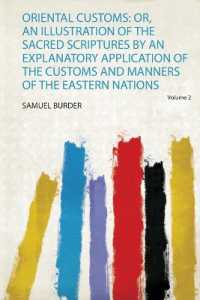Full Description
SOAR Teaching Frames for Literacy provides a unique approach to planning, implementing, and elevating instruction that drives improvement in teaching and learning. SOAR focuses on the high-impact teaching practices that research identifies as key to student learning. In this book, the authors present and unpack these practices within the context of Teaching Frames. The frames provide a common language and a set of tools to foster informal self-evaluation, as well as teacher-to-teacher and coach-to-teacher collaboration. All stages of implementation are illustrated with classroom examples from the authors' 15 years of research and professional development throughout the United States. School principals, coaches, and classroom teachers can use Literacy Classrooms That S.O.A.R. to support professional learning and growth across schools and districts. Book Features:
Instructional strategies with step-by-step guidance for implementation.
Vignettes that demonstrate how to implement SOAR in a variety of contexts.
Visuals of instructional resources that teachers can use.
Rubrics that can be used by instructional leaders, literacy coaches, and professional learning communities.
Question and answer sections to help teachers differentiate practices to meet the needs of all students.
Contents
Contents
Foreword Douglas Fisher vii
Acknowledgments ix
1. Introducing the SOAR Teaching Frames 1
A Research-Based Approach to Elevating Instruction 2
Elevating Teaching Practice in Support of New Standards 3
Step Inside Ms. Aguirre's Classroom 3
Step Inside Ms. Rahim's Classroom 5
The SOAR Practices 7
SOAR Teaching Frames 10
Findings From Our Work in the Field 12
Conclusion 14
2. Disciplinary Discussions 15
Using the SOAR Lens to Plan and Reflect 16
Step Inside Ms. Vu's Classroom 24
Implementing the Disciplinary Discussions Teaching Frame 29
Additional Implementation Considerations 49
Conclusion 51
3. Disciplinary Interactions With Complex Text 52
Using the SOAR Lens to Plan and Reflect 52
Step Inside Mr. Ortiz's Classroom 60
Implementing the Disciplinary Interactions With Complex Text Teaching Frame 65
Additional Implementation Considerations 86
Conclusion 87
4. Disciplinary Uses of Evidence 89
Using the SOAR Lens to Plan and Reflect 89
Step Inside Mr. O'Connor's Classroom 96
Implementing the Disciplinary Uses of Evidence Teaching Frame 102
Additional Implementation Considerations 120
Conclusion 122
5. Disciplinary Communication 123
Using the SOAR Lens to Plan and Reflect 123
Step Inside Ms. Alvarez's Classroom 131
Implementing the Disciplinary Communication Teaching Frame 134
Additional Implementation Considerations 156
Conclusion 158
6. Supporting Teachers to Build Literacy Classrooms That SOAR 159
Fostering an Ability to Teach with Metacognition 160
Supporting the Collective Growth of Teachers Through Professional Learning Communities 163
Step Inside Rockville School 165
Building a Culture of Professional Growth Districtwide 167
Step Inside South End School District 167
Conclusion 170
Appendix A: Conversation Prompts and Responses 172
Appendix B: American Symbols 173
Appendix C: Buffalo Soldiers 174
Appendix D: Formative Assessments of Student Talk—Disciplinary Discussions 176
Appendix E: Formative Assessments of Student Talk—Disciplinary Communication 178
Appendix F: Implementation Rubric—Disciplinary Discussions Teaching Frame 180
Appendix G: Implementation Rubric—Disciplinary Interactions With Complex Text 185
Appendix H: Implementation Rubric—Disciplinary Uses of Evidence 186
Appendix I: Implementation Rubric—Disciplinary Communication 187
References 189
Bibliography 193
Index 195
About the Authors 203






